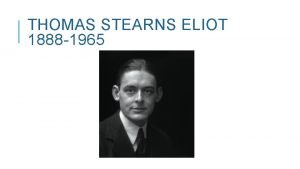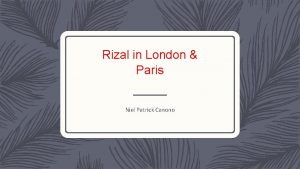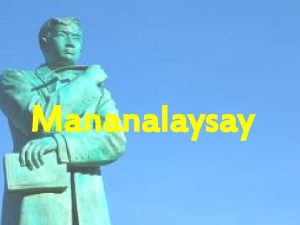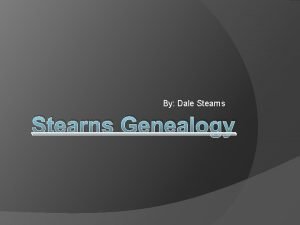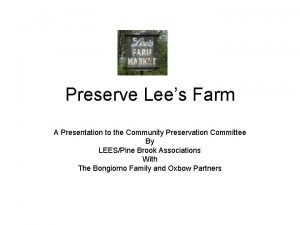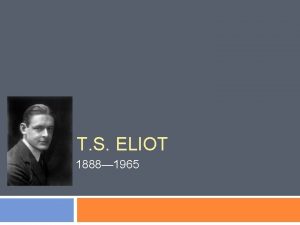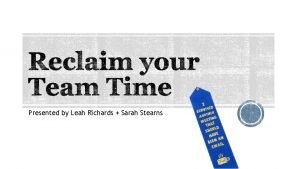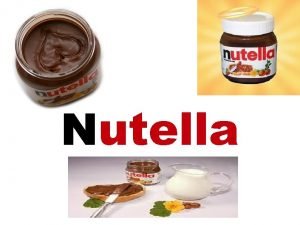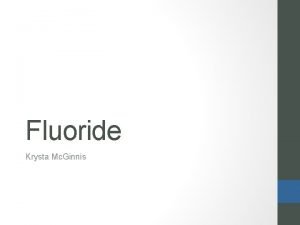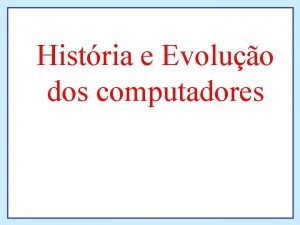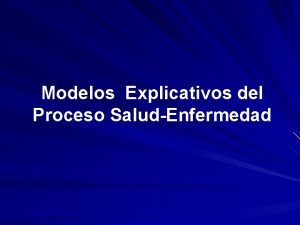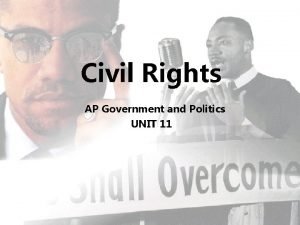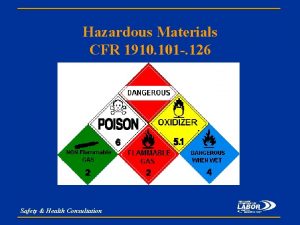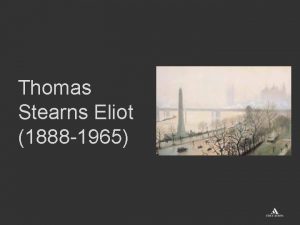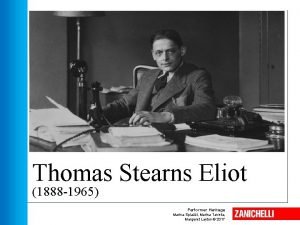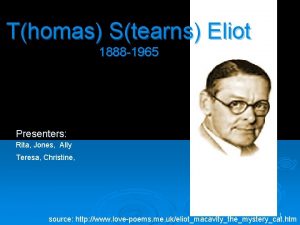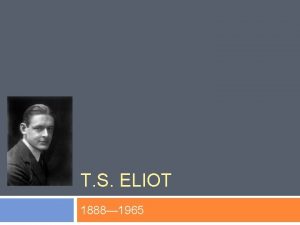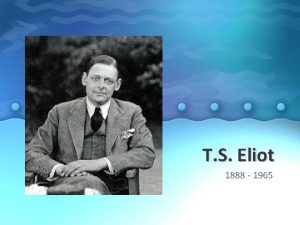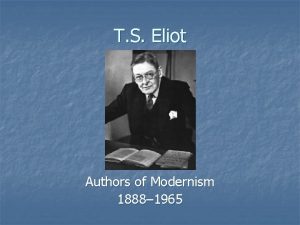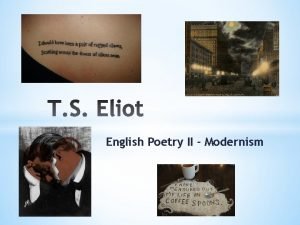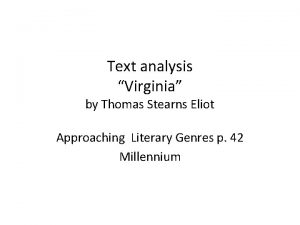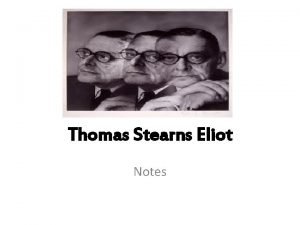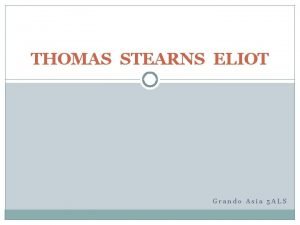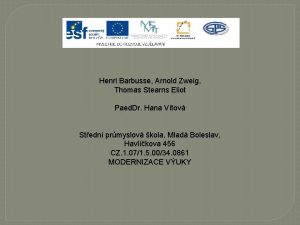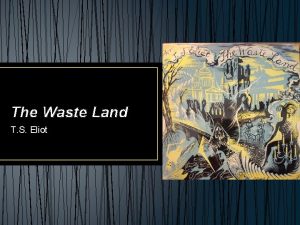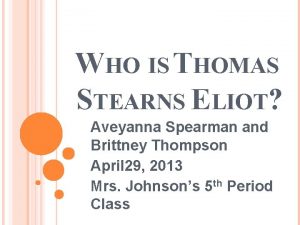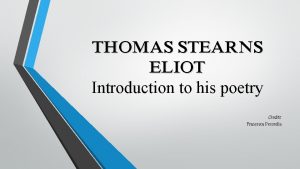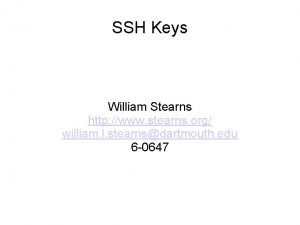Thomas Stearns Eliot 1888 1965 Thomas Stearns Eliot


















- Slides: 18

Thomas Stearns Eliot (1888 -1965) Thomas Stearns Eliot.

T. S. Eliot 1. Life • 1888: he was born in St. Louis, Missouri. • 1910: he studied in Paris at the Sorbonne. • 1915: he married the British ballet dancer Vivienne Haigh-Wood. • 1917: he established himself as an important avant-garde poet. Thomas Stearns Eliot. Only Connect. . . New Directions

T. S. Eliot 1. Life • 1922: he edited The Criterion, an intellectual magazine. His professions included being a poet, a critic and an editor. • 1925: he became director for the publishers “Faber & Faber”. • 1927: he acquired British citizenship and converted to Anglicanism. Thomas Stearns Eliot. Only Connect. . . New Directions

T. S. Eliot 1. Life • 1930: for the next thirty years he was considered as “the most dominant figure in poetry and literary criticism in the Englishspeaking world”. • 1948: he received the Nobel Prize for literature. • 1965: he died in London. Thomas Stearns Eliot. Only Connect. . . New Directions

T. S. Eliot 2. Works Before the conversion 1917: Prufrock and other Observations. 1922: The Waste Land. It is said to be “the single most influential poetic work of the twentieth century”. 1925: The Hollow Men. Cover for the first edition of Prufrock and other Observations Only Connect. . . New Directions

T. S. Eliot 2. Works After the conversion 1927: Ariel Poems. 1930: Ash-Wednesday. 1935 -1942: Four Quartets. 1935: Murder in the Cathedral. 1939: Family Reunion. A contemporary edition of Murder in the Cathedral Only Connect. . . New Directions

T. S. Eliot 3. T. S. Eliot’s world and the 19 th-century world Modern/T. S. Eliot’s world 19 th- century world Chaotic Ordered Futile Meaningful Pessimistic Optimistic Unstable Stable Loss of faith Faith Collapse of moral values Morality/Values Confused sense of identity Clear sense of identity Only Connect. . . New Directions

T. S. Eliot 4. The Love Song of J. Alfred Prufrock Poetic form: a dramatic monologue. Content: the protagonist’s realization of death within life, the lost opportunities in his life and the lack of any spiritual progress. The speaker: a middle-aged passive, aimless man. He is linked to: 1. physical and intellectual inertia. 2. inability to communicate with his fellow-beings. Style: juxtaposition of poetic images with everyday phrases and images; objective correlative instead of direct statements. Only Connect. . . New Directions

T. S. Eliot 5. The Waste Land: content • It is an autobiography written in a moment of crisis in the life of the poet. • It consists of five sections; it reflects the fragmented experience of the 20 thcentury sensibility of the great modern cities of the West. A contemporary edition of The Waste Land. Only Connect. . . New Directions

T. S. Eliot 5. The Waste Land: content • It is an anthology of indeterminate states of the mind, hallucinations, impressions, personalities blended and superimposed beyond the boundaries of time and place. • The speaking voice is related to various personalities: Tiresias, a knight from the Grail legend, the Fisher King. Only Connect. . . New Directions A contemporary edition of The Waste Land.

T. S. Eliot 6. The Waste Land: themes • The disillusionment and disgust of the period after World War I. • Contrast between past fertility and present sterility. • The mythical past linked to a new concept of History repetition of the same events. • Spring Symbols: different from Chaucer absence of rebirth. April is the cruelest month, breeding Lilacs out of the dead land, mixing Memory and desire, stirring Dull roots with spring rain. (I section) Only Connect. . . New Directions

T. S. Eliot 7. The Waste Land: style • Association of ideas past and present are simultaneous. • Mythical method to give significance to present futility. • Subjective experiences made universal. • Use of Juxtaposition. First draft of The Waste Land, third section. Only Connect. . . New Directions

T. S. Eliot 7. The Waste Land: style • Quotations from different languages and literary works. • Fragmentation. • Technique of implication: the active participation of the reader is required. • Objective correlative. • Repetition of words, images and phrases. Only Connect. . . New Directions First draft of The Waste Land, third section.

T. S. Eliot 8. The objective correlative: T. S. Eliot and Montale For Eliot, the “objective correlative” is a pattern of objects, events, actions, or a situation that can serve effectively to awaken in the reader an emotional response without being a direct statement of that subjective emotion. Only Connect. . . New Directions

T. S. Eliot 8. The objective correlative: T. S. Eliot and Montale What The Thunder said Meriggiare pallido e assorto (“Ossi di Seppia”) Here is no water but only rock Rock and no water and the sandy road The road winding above among the mountains Which are mountains of rock without water. Meriggiare pallido e assorto presso un rovente muro d’orto, ascoltare tra i pruni e gli sterpi schiocchi di merli, frusci di serpi. Ø Both Eliot and Montale depict a desolate landscape. Ø They both refer to a waste land of the spirit. Ø This landscape is cosmopolitan in Eliot. Ø It is a domestic landscape in Montale. Only Connect. . . New Directions

T. S. Eliot 9. The Hollow Men • Linked to The Waste Land. • Main themes: despair and desolation. • No redemption is possible because of the lack of faith. • Parallel between past and present. Only Connect. . . New Directions

T. S. Eliot 10. Journey of the Magi (Ariel Poems) Written after his conversion to Christianity. Content: the journey to the birthplace of Christ told by one of the Magi. • No celebration: the journey is painful and meaningless. • At first there is the regret of the previous life characterised by alienation. The Journey of the Magi fragment of a picture with the Adoration of the Magi, Sassetta, Metropolitan Museum of Art, New York. Only Connect. . . New Directions

T. S. Eliot 10. Journey of the Magi (Ariel Poems) Written after his conversion to Christianity. Content: the journey to the birthplace of Christ told by one of the Magi. • End of paganism in the last lines. The Journey of the Magi fragment of a picture with the Adoration of the Magi, Sassetta, Metropolitan Museum of Art, New York. • The Magus cannot feel at home among “an alien people clutching their gods” (line 42). This captures the awkwardness felt by the faithful among nonbelievers and vice-versa. Only Connect. . . New Directions
 Tom stern eliot
Tom stern eliot Observation of rizal in london
Observation of rizal in london Inglatera 1888
Inglatera 1888 John starnes biography
John starnes biography Bill stearns
Bill stearns Stearns
Stearns Stearns farm stand
Stearns farm stand When was ts eliot born
When was ts eliot born Sarah stearns
Sarah stearns Nutella weetjes
Nutella weetjes Deficiency of
Deficiency of Geração 1955
Geração 1955 Akta wang tak dituntut 1965 (pindaan 2002)
Akta wang tak dituntut 1965 (pindaan 2002) 16 oktober 1965
16 oktober 1965 Krankenpflegegesetz 1965
Krankenpflegegesetz 1965 Cadena epidemiologica del sarampion
Cadena epidemiologica del sarampion 1965 march
1965 march Osha 1910 psm
Osha 1910 psm Payment of bonus act 1965
Payment of bonus act 1965
